Analysis of Water Migration and Spoil Slope Stability under the Coupled Effects of Rainfall and Root Reinforcement Based on the Unsaturated Soil Theory
Abstract
1. Introduction
2. Materials and Methods
2.1. Materials and Test Methods
2.1.1. Study Site
2.1.2. Soil Samples
2.1.3. Direct Shear Tests
2.2. Governing Equations
2.2.1. Equations Describing the Seepage in Unsaturated Soils
2.2.2. Equations Describing the Stress in Unsaturated Soils
2.3. Numerical Solution Method
2.3.1. Geometric Parameters and Model
2.3.2. Rainfall Infiltration
2.4. Experimental Validation Method
3. Results
3.1. Shear Strength for Different Specimens
3.2. Effective Saturation and Pore Water Pressure
3.3. Safety Factor
3.4. Factors Affecting the Stability of the Vegetated Slope
3.4.1. Slope Angle
3.4.2. Rainfall
3.4.3. Vegetation
3.5. In-Site Experimental Validation
4. Discussions
4.1. Root Reinforcement Effectiveness
4.2. Relationship between Landslide and Water in the Soil
4.3. Influence of Slope Angle, Rainfall, and Vegetation on the Vegetated Slope Stability
4.4. Slope Failure Mechanism
5. Conclusions
Author Contributions
Funding
Data Availability Statement
Conflicts of Interest
References
- Chen, R.; Ge, Y.H.; Chen, Z.K.; Liu, J.; Zhao, Y.R.; Li, Z.H. Analytical solution for one-dimensional contaminant diffusion through unsaturated soils beneath geomembrane. J. Hydrol. 2019, 568, 260–274. [Google Scholar] [CrossRef]
- Meijer, G.J. A generic form of fibre bundle models for root reinforcement of soil. Plant Soil 2021, 468, 45–65. [Google Scholar] [CrossRef]
- Ogila, W. Analysis and assessment of slope instability along international mountainous road in North Africa. Nat. Hazards 2021, 106, 2479–2517. [Google Scholar] [CrossRef]
- Li, S.H.; Cui, P.; Cheng, P.; Wu, L.Z. Modified Green–Ampt model considering vegetation root effect and redistribution characteristics for slope stability analysis. Water Resour. Manag. 2022, 36, 2395–2410. [Google Scholar] [CrossRef]
- Li, Y.P.; Wang, Y.Q.; Ma, C.; Zhang, H.L.; Wang, Y.J.; Song, S.S.; Zhu, J.Q. Influence of the spatial layout of plant roots on slope stability. Ecol. Eng. 2016, 91, 477–486. [Google Scholar] [CrossRef]
- Ji, J.N.; Kokutse, N.; Genet, M.; Fourcaud, T.; Zhang, Z.Q. Effect of spatial variation of tree root characteristics on slope stability. A case study on Black Locust (Robinia pseudoacacia) and Arborvitae (Platycladus orientalis) stands on the Loess Plateau, China. Catena 2012, 92, 139–154. [Google Scholar] [CrossRef]
- Su, L.J.; Hu, B.L.; Xie, Q.J.; Yu, F.W.; Zhang, C.L. Experimental and theoretical study of mechanical properties of root-soil interface for slope protection. J. Mt. Sci. 2020, 17, 2784–2795. [Google Scholar] [CrossRef]
- Wang, Y.X.; Chai, J.R.; Cao, J.; Qin, Y.; Xu, Z.G.; Zhang, X.X. Effects of seepage on a three-layered slope and its stability analysis under rainfall conditions. Nat. Hazards 2020, 102, 1269–1278. [Google Scholar] [CrossRef]
- Liu, Z.Z.; Yan, Z.X.; Qiu, Z.H.; Wang, X.G.; Li, J.W. Stability analysis of an unsaturated soil slope considering rainfall infiltration based on the Green-Ampt model. J. Mt. Sci. 2020, 17, 2577–2590. [Google Scholar] [CrossRef]
- Palazzolo, N.; Peres, D.J.; Creaco, E.; Cancelliere, A. Using principal component analysis to incorporate multi-layer soil moisture information in hydrometeorological thresholds for landslide prediction: An investigation based on ERA5-Land reanalysis data. Nat. Hazards Earth Syst. Sci. 2023, 23, 279–291. [Google Scholar] [CrossRef]
- Khan, K.U.J.; Wang, C.; Khan, M.W.J.; Liang, Z.; Li, S.; Li, B. Influence of rainfall infiltration on the stability of unsaturated coal gangue accumulated slope. J. Mt. Sci. 2021, 18, 1696–1709. [Google Scholar] [CrossRef]
- Ren, Y.; Li, T.B.; Dong, S.M.; Tang, J.L.; Xue, D.M. Rainfall-induced reactivation mechanism of a landslide with multiple-soft layers. Landslides 2020, 17, 1269–1281. [Google Scholar] [CrossRef]
- Kumar, S.; Roy, L.B. Experimental and Numerical Analysis of Unsaturated Soil Slope Stability with Rainfall and Jute Fibre Reinforcement Condition. Geotech. Eng. 2023, 54, 15–32. [Google Scholar]
- Mao, Z.; Wang, Y.; Mccormack, M.; Rowe, N.; Deng, X.B.; Yang, X.D.; Shangwen, X.; Nespoulous, J.; Sidle, R.; Guo, D.; et al. Mechanical traits of fine roots as a function of topology and anatomy. Ann. Bot. 2018, 122, 1103–1116. [Google Scholar] [CrossRef] [PubMed]
- Li, Y.P.; Hu, C.; Jian, L.; Zhao, R.; Li, C. Evaluation of the stability of vegetated slopes according to layout and temporal changes. J. Mt. Sci. 2021, 18, 275–290. [Google Scholar] [CrossRef]
- Hao, G.L.; Wang, L.G.; Liu, X.F. Methods for Studying the Effect of Plant Roots on Soil Mechanical Reinforcement: A Review. J. Soil Sci. Plant Nutr. 2023, 23, 2893–2912. [Google Scholar] [CrossRef]
- Wu, T.H.; Mckinnell, W.P.; Swanston, D.N. Strength of tree roots and landslides on Prince of Wales Island, Alaska. Can. Geotech. J. 1979, 16, 19–33. [Google Scholar] [CrossRef]
- Zhu, J.; Leung, A.; Wang, Y. Modelling root–soil mechanical interaction considering root pull-out and breakage failure modes. Plant Soil 2022, 480, 675–701. [Google Scholar] [CrossRef]
- Thomas, R.; Pollen-Bankhead, N. Modeling root-reinforcement with a fiber-bundle model and Monte Carlo simulation. Ecol. Eng. 2010, 36, 47–61. [Google Scholar] [CrossRef]
- Ying, Z.X.; Liu, Y.J.; Shi, C.; Lan, Z.C.; Zhang, H.; Ge, G. Simulating root distribution of plant individual with a three-dimensional model. Ecol. Model. 2021, 455, 109649. [Google Scholar] [CrossRef]
- Mao, Z.; Roumet, C.; Rossi, L.; Merino-Martín, L.; Nespoulous, J.; Taugourdeau, O.; Boukcim, H.; Fourtier, S.; Rey Granado, M.; Ramel, M.; et al. Intra- and inter-specific variation in root mechanical traits for twelve herbaceous plants and their link with the root economics space. Oikos 2022, 2023, e09032. [Google Scholar] [CrossRef]
- Masi, E.B.; Tofani, V.; Rossi, G.; Cuomo, S.; Wu, W.; Salciarini, D.; Caporali, E.; Catani, F. Effects of roots cohesion on regional distributed slope stability modelling. Catena 2023, 222, 106853. [Google Scholar] [CrossRef]
- Qin, C.B.; Wang, R.; Chen, W.K.; Shi, Y.S.; Sun, H.X.; Tang, J.J.; Wang, L.Q. Stability of Ficus virens-Reinforced Slopes Considering Mechanical and/or Hydrological Effects. Forests 2024, 15, 133. [Google Scholar] [CrossRef]
- Wu, L.Z.; Cheng, P.; Zhou, J.T.; Li, S.H. Analytical solution of rainfall infiltration for vegetated slope in unsaturated soils considering hydro-mechanical effects. Catena 2022, 217, 106472. [Google Scholar] [CrossRef]
- Terzaghi, K.T. Theoretical Soil Mechanics; USA Theoretical Soil Mechanics; INC: New York, NY, USA, 1943; p. 49. [Google Scholar]
- Liu, Q.; Huang, J.K.; Zhang, Z.W.; Liu, G.M.; Jiang, Q.O.; Liu, L.H.; Khan, I. Effect of freeze-thaw cycles on the shear strength of root-soil composite. Materials 2024, 17, 285. [Google Scholar] [CrossRef] [PubMed]
- Zhao, M.Y.; Xie, Q.; Ren, X.H.; Zhu, L.; Chen, P.F. Experimental research on the deformation and failure characteristics of coarse-grained soil slopes in seasonal frozen region along Sichuan-Tibet Railway. IOP Conf. Ser. Earth Environ. Sci. 2020, 455, 12135. [Google Scholar] [CrossRef]
- Araújo-Neto, R.; Magalhães, I.; Lyra, G.; Maia, S.; Lyra, G. Physical and hydrological characteristics and modelling of the soil water retention curve in the brazilian semi-arid region. Biosci. J. 2022, 38, e380311-13. [Google Scholar] [CrossRef]
- GB/T 50123-2019; Ministry of Housing and Urban Rural Development of the People’s Republic of China. Standard for Geotechnical Testing Method. China Planning Press: Beijing, China, 2019; pp. 122–125.
- Hou, J.; Yang, J.Y.; Tan, J. A new method for revealing spatial relationships between shrubs and soil resources in arid regions. Catena 2019, 183, 104187. [Google Scholar] [CrossRef]
- Ran, T.; Huang, Z.Q.; Meng, L.C.; Wang, C.; Li, X.L. Mechanisms and stabilization measures of layered slope: A Study case of a layered slope in Sichuan, China. Geotech. Geol. Eng. 2022, 40, 785–794. [Google Scholar] [CrossRef]
- Bao, Y.D.; Li, Y.C.; Zhang, Y.S.; Yan, J.H.; Zhou, X.; Zhang, X.D. Investigation of the role of crown crack in cohesive soil slope and its effect on slope stability based on the extended finite element method. Nat. Hazards 2022, 110, 295–314. [Google Scholar] [CrossRef]
- GB 51018–2014; Ministry of Housing and Urban Rural Development of the People’s Republic of China. Code for Design of Soil and Water Conservation Engineering. China Planning Press: Beijing, China, 2014; pp. 20–24.
- Fiolleau, S.; Uhlemann, S.; Falco, N.; Dafflon, B. Assessing probability of failure of urban landslides through rapid characterization of soil properties and vegetation distribution. Geomorphology 2022, 423, 108560. [Google Scholar] [CrossRef]
- Feng, S.; Liu, H.W.; Ng, C.W.W. Analytical analysis of the mechanical and hydrological effects of vegetation on shallow slope stability. Comput. Geotech. 2020, 118, 103335. [Google Scholar] [CrossRef]
- Gholami, V.; Sahour, H.; Khaleghi, M.; Yousefi, A. Evaluating the effects of vegetation and land management on runoff control using field plots and machine learning models. Environ. Sci. Pollut. Res. 2022, 30, 31202–31217. [Google Scholar] [CrossRef] [PubMed]
- Gao, Q.F.; Zeng, L.; Shi, Z.N. Effects of desiccation cracks and vegetation on the shallow stability of a red clay cut slope under rainfall infiltration. Comput. Geotech. 2021, 140, 104436. [Google Scholar] [CrossRef]
- Yang, S.R.; Huang, L.J. Infiltration and failure behavior of an unsaturated soil slope under artificial rainfall model experiments. Water 2023, 15, 1599. [Google Scholar] [CrossRef]

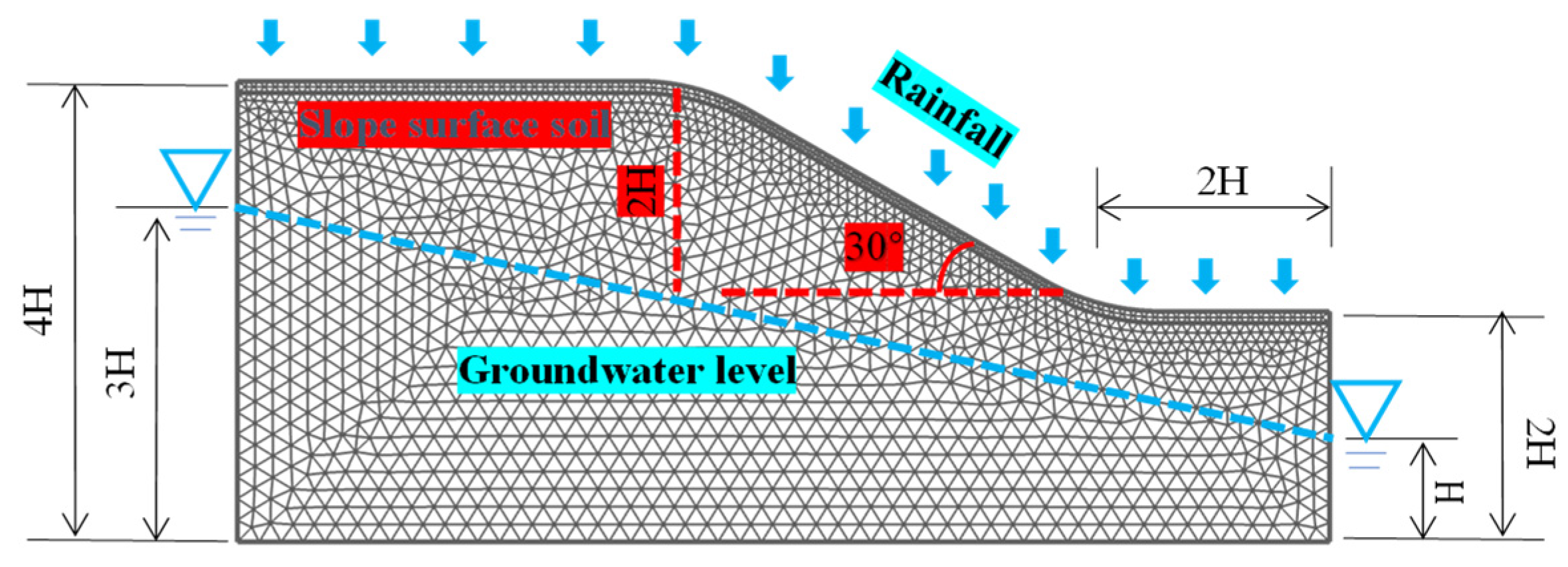
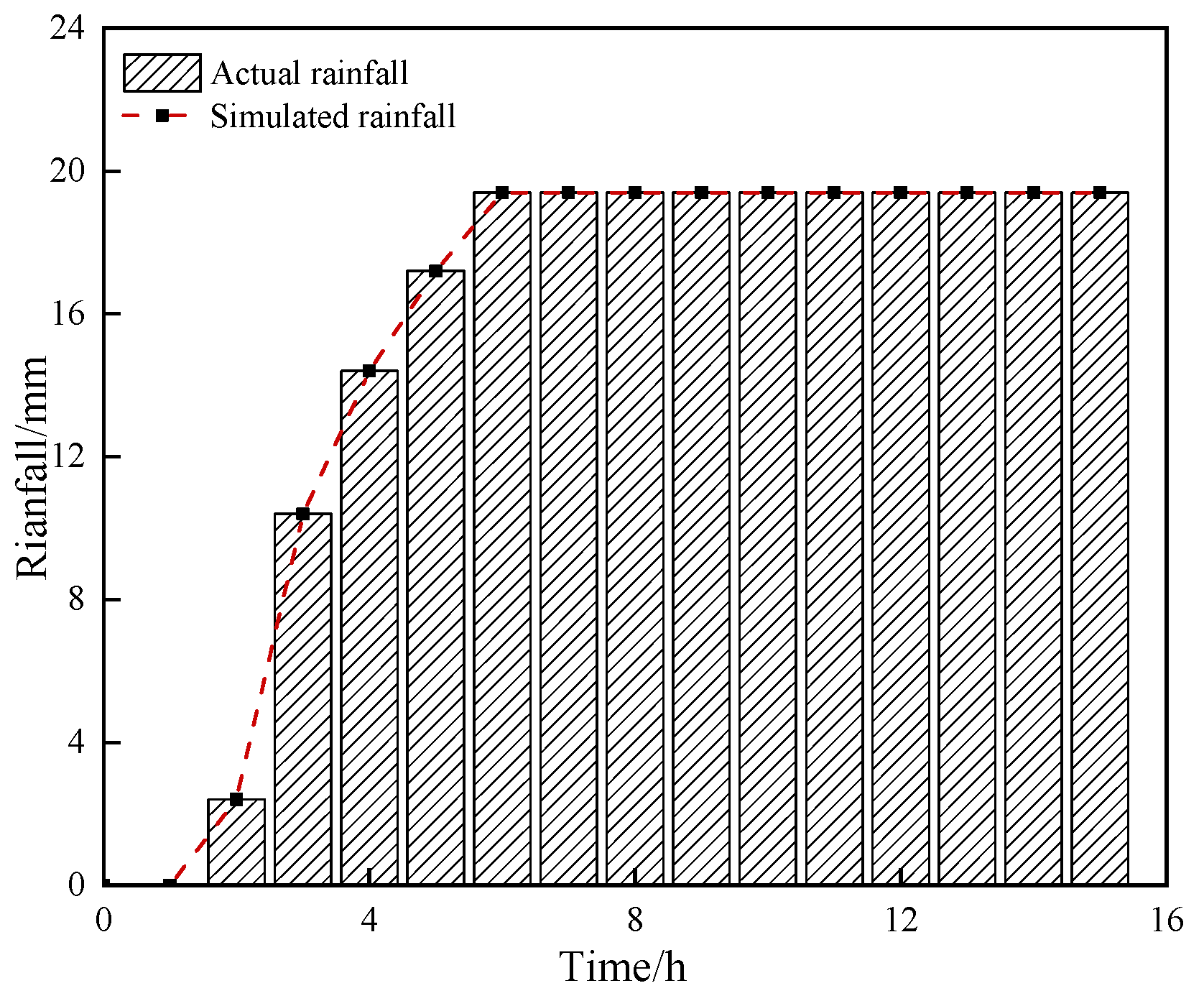
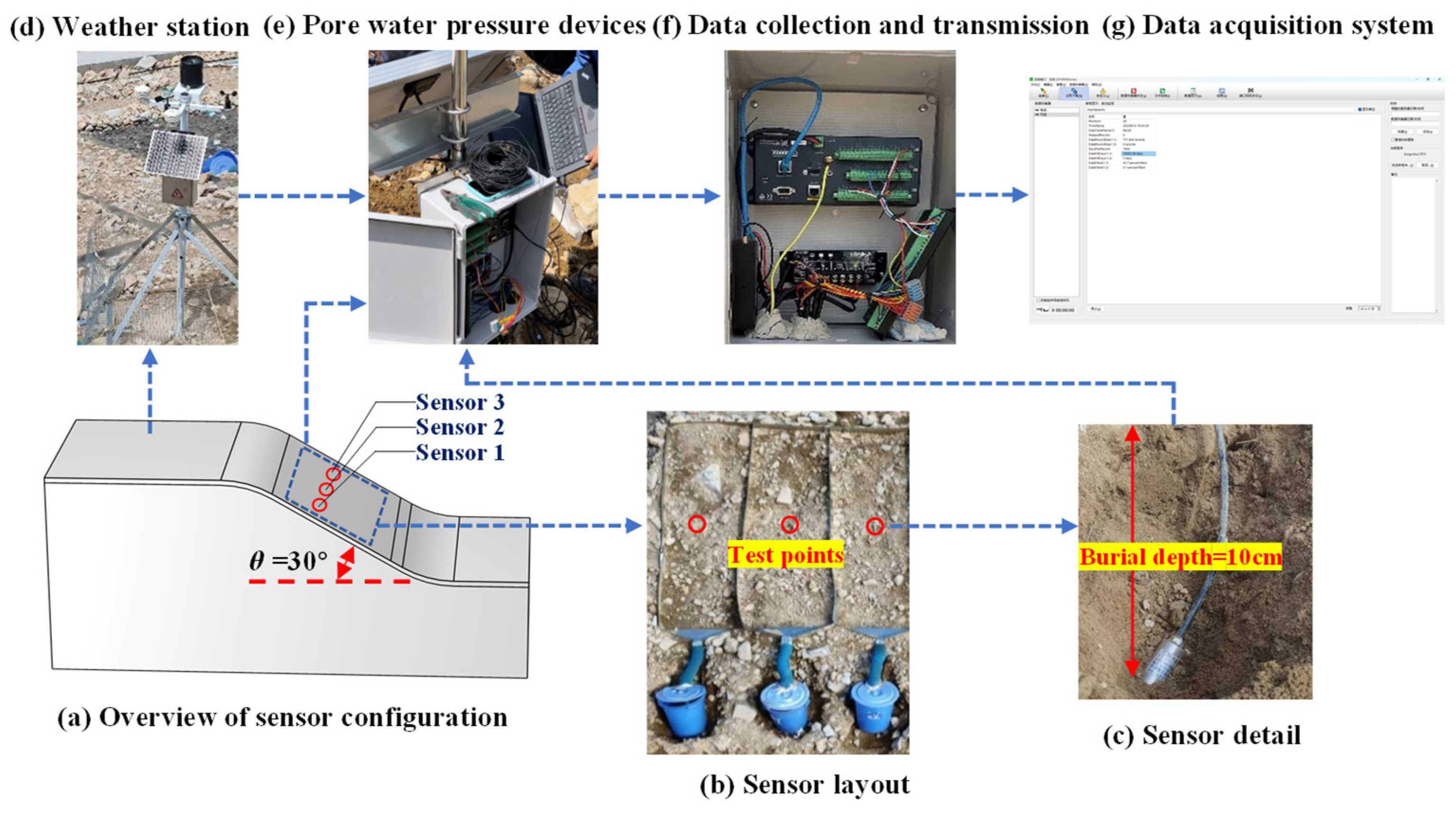


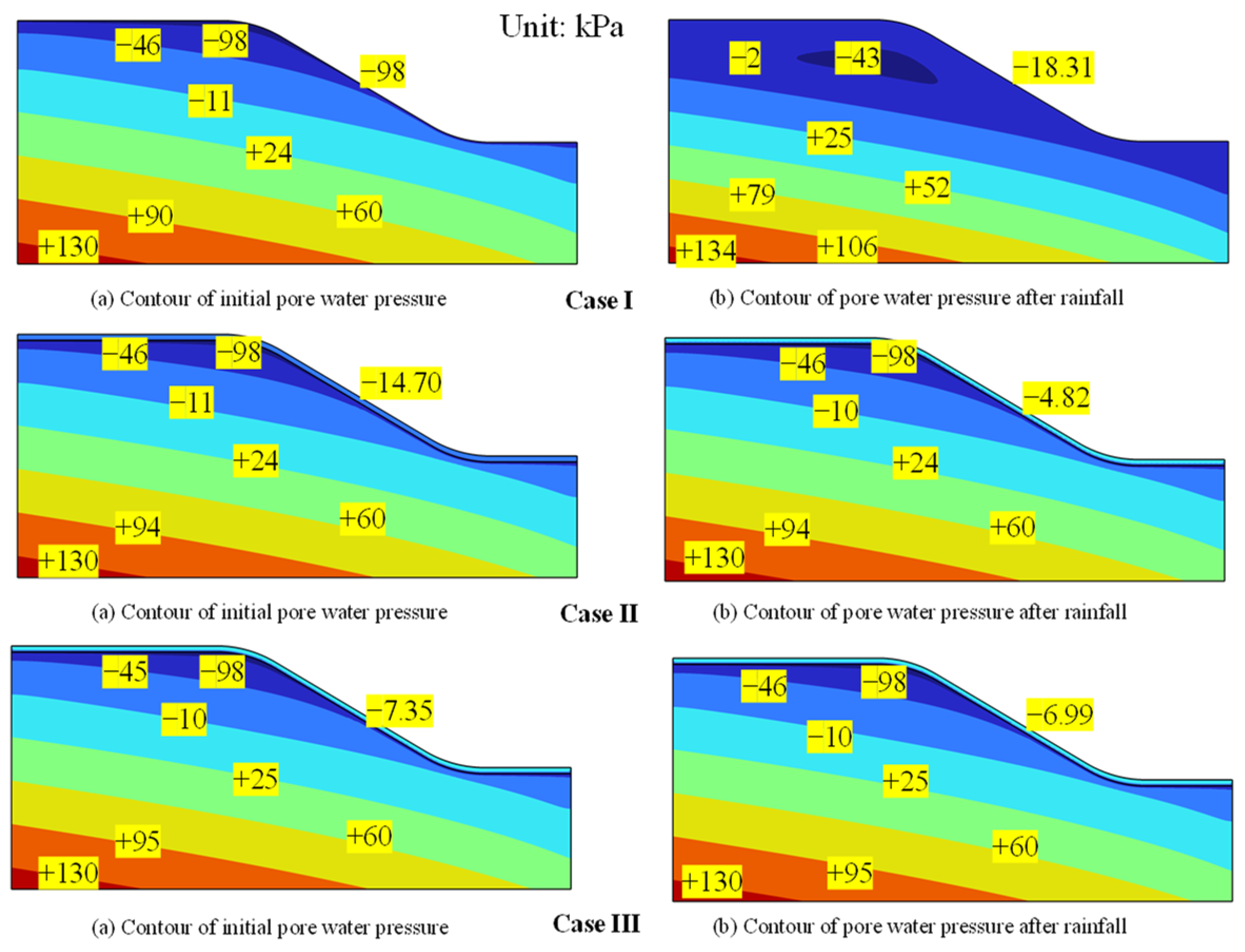

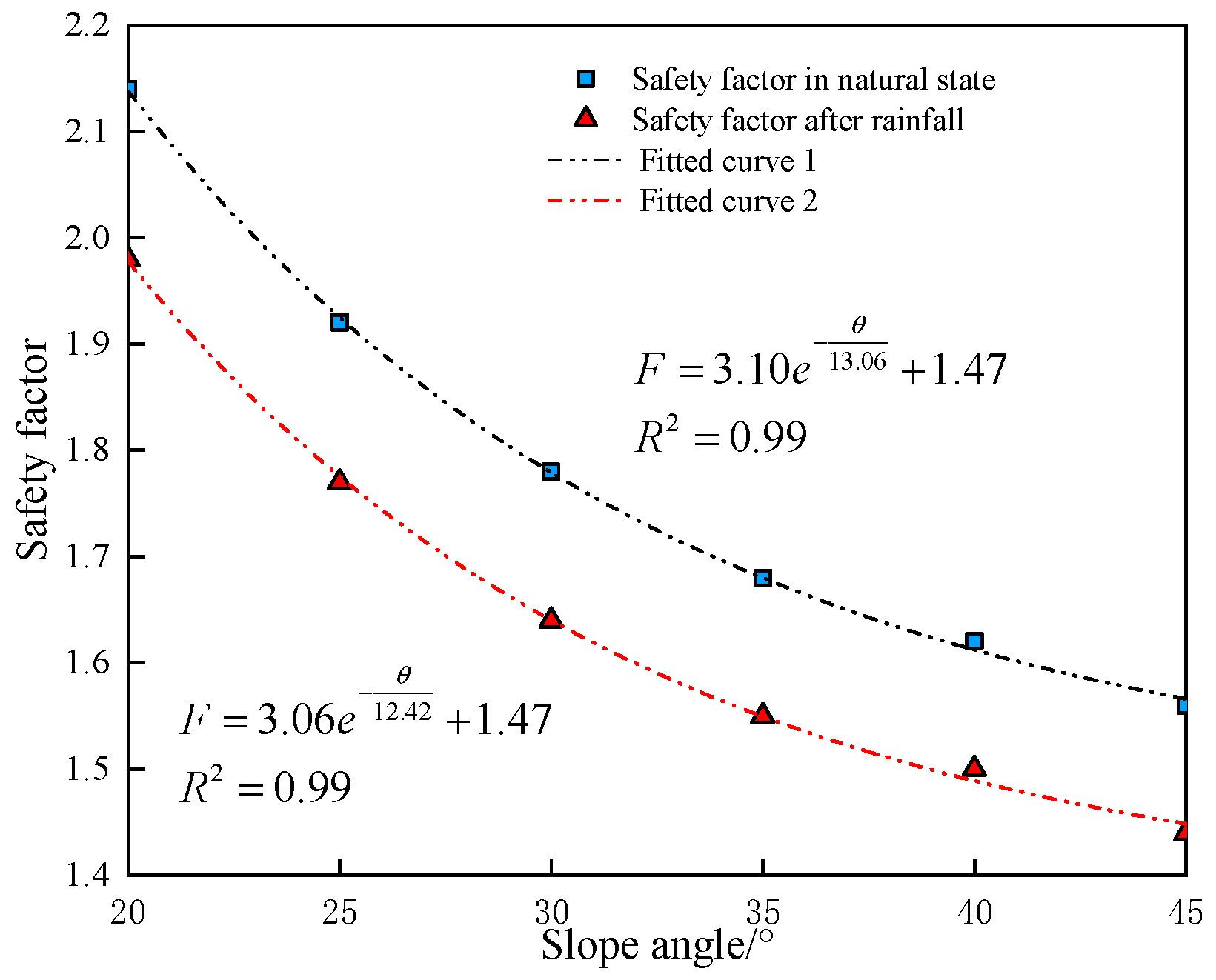

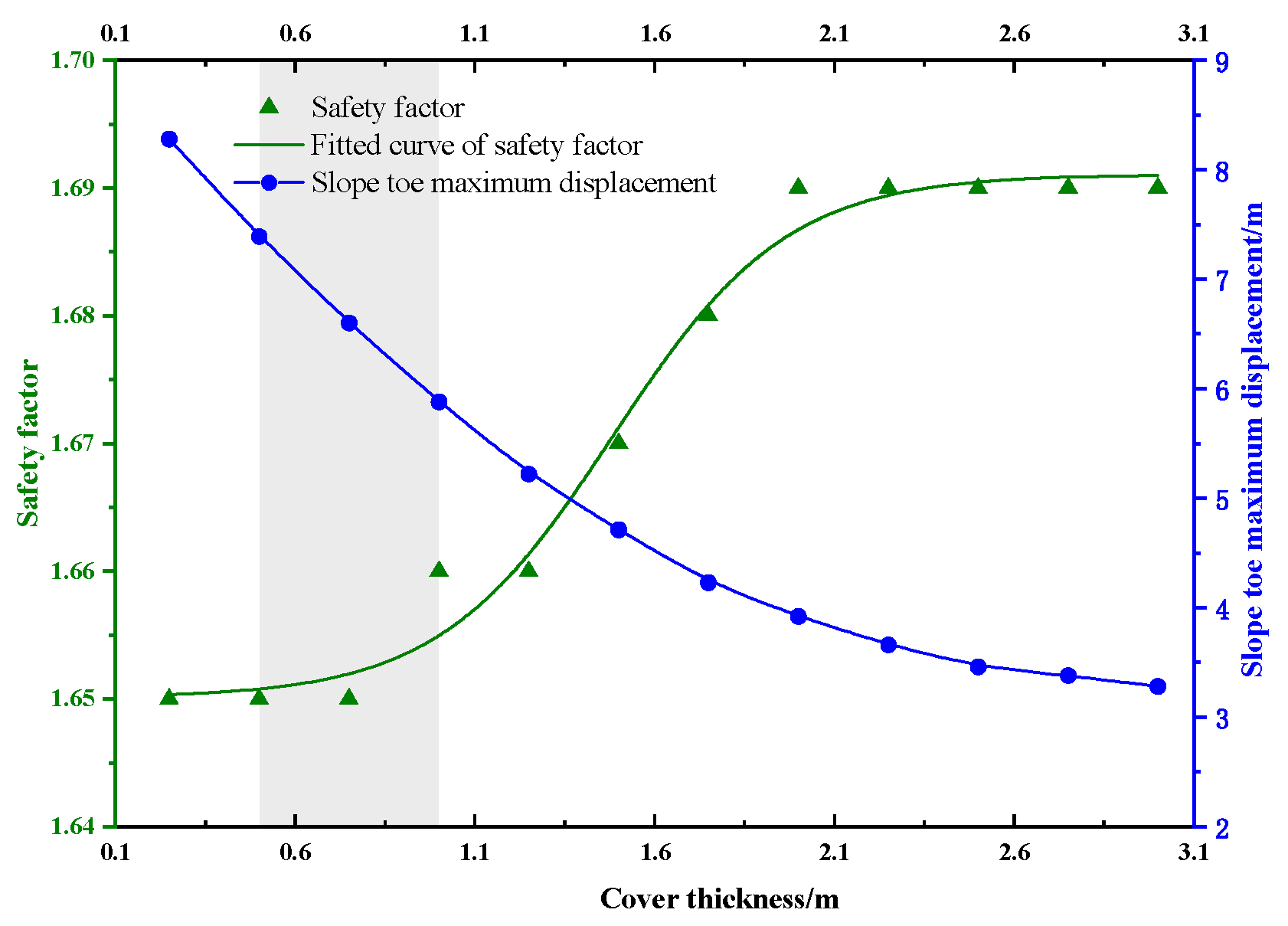
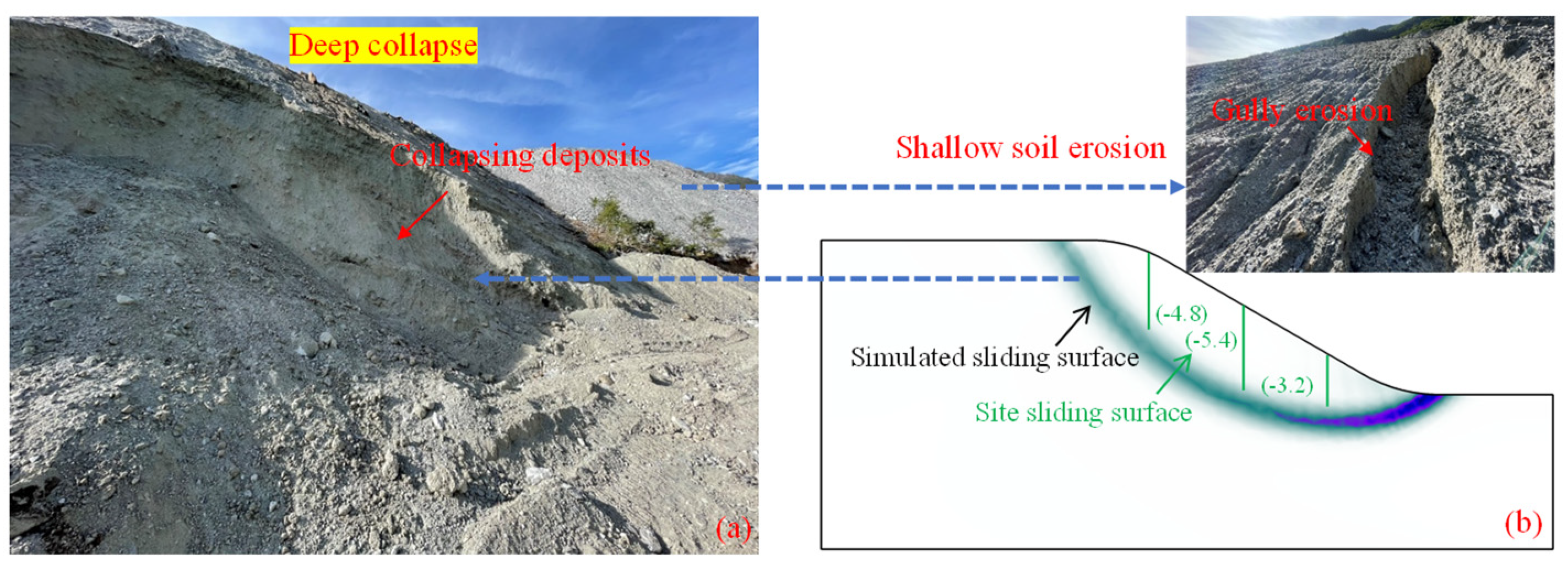
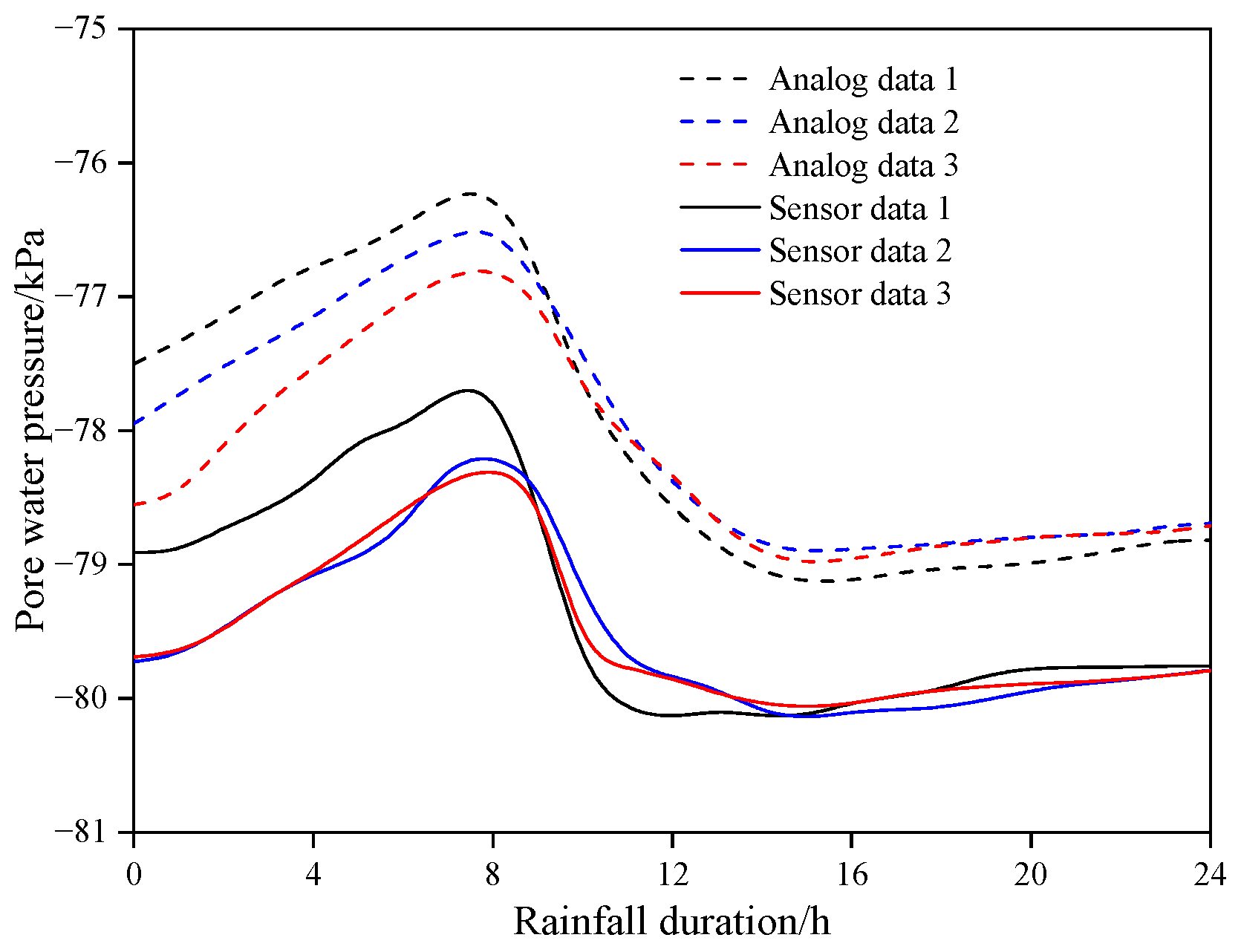
| Material | Density ρ (kg·m−3) | Elastic Modulus E (MPa) | Poisson Ratio μ | Cohesion c (kPa) | Internal Friction Angle φ (°) | Saturated Permeability Coefficient ks (m·s−1) | Natural Water Content θo (%) | Saturated Water Content θs (%) |
|---|---|---|---|---|---|---|---|---|
| Engineering spoil | 1695 | 20 | 0.25 | 12 | 23.78 | 6.0 × 10−4 | 4.05% | 36.1% |
| Overburden soil | 1662 | 10 | 0.20 | 25.15 | 17.33 | 5.55 × 10−5 | 32.47% | 48.9% |
| Root–soil composite | 1281 | 13.8 | 0.24 | 33.25 | 12.81 | 4.17 × 10−5 | 50.14% | 62.3% |
Disclaimer/Publisher’s Note: The statements, opinions and data contained in all publications are solely those of the individual author(s) and contributor(s) and not of MDPI and/or the editor(s). MDPI and/or the editor(s) disclaim responsibility for any injury to people or property resulting from any ideas, methods, instructions or products referred to in the content. |
© 2024 by the authors. Licensee MDPI, Basel, Switzerland. This article is an open access article distributed under the terms and conditions of the Creative Commons Attribution (CC BY) license (https://creativecommons.org/licenses/by/4.0/).
Share and Cite
Song, H.; Huang, J.; Zhang, Z.; Jiang, Q.; Liu, L.; He, C.; Zhou, Y. Analysis of Water Migration and Spoil Slope Stability under the Coupled Effects of Rainfall and Root Reinforcement Based on the Unsaturated Soil Theory. Forests 2024, 15, 640. https://doi.org/10.3390/f15040640
Song H, Huang J, Zhang Z, Jiang Q, Liu L, He C, Zhou Y. Analysis of Water Migration and Spoil Slope Stability under the Coupled Effects of Rainfall and Root Reinforcement Based on the Unsaturated Soil Theory. Forests. 2024; 15(4):640. https://doi.org/10.3390/f15040640
Chicago/Turabian StyleSong, Huanran, Jiankun Huang, Zhiwei Zhang, Qunou Jiang, Lanhua Liu, Caisong He, and Yang Zhou. 2024. "Analysis of Water Migration and Spoil Slope Stability under the Coupled Effects of Rainfall and Root Reinforcement Based on the Unsaturated Soil Theory" Forests 15, no. 4: 640. https://doi.org/10.3390/f15040640
APA StyleSong, H., Huang, J., Zhang, Z., Jiang, Q., Liu, L., He, C., & Zhou, Y. (2024). Analysis of Water Migration and Spoil Slope Stability under the Coupled Effects of Rainfall and Root Reinforcement Based on the Unsaturated Soil Theory. Forests, 15(4), 640. https://doi.org/10.3390/f15040640






